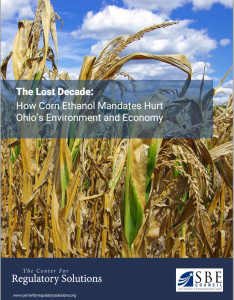Full Title: The Lost Decade: How Corn Ethanol Mandates Hurt Ohio’s Environment and Economy
Author(s): Center for Regulatory Analysis
Publisher(s): Center for Regulatory Analysis
Publication Date: November 1, 2015
Full Text: Download Resource
Description (excerpt):
On November 30, 2015, the United Nations (U.N.) will convene its annual Conference of the Parties meeting in Paris to discuss solutions for addressing climate change and reducing greenhouse gas (GHG) emissions. That same day, the Environmental Protection Agency (EPA) is expected to issue updated rules mandating an increase in the volume of biofuels that must be added to the nation’s fuel supply, a mandate that EPA claims will reduce GHGs and contribute to a better and cleaner environment.
Building up to the U.N. meeting in Paris, President Obama and the EPA have sought to implement a sweeping regulatory agenda designed to fundamentally recast the U.S. energy sector, starting with the controversial Clean Power Plan, and more recently seeking to implement more restrictive rules for ground-level ozone, a regulation that some consider the most expensive in history. Unfortunately for small businesses struggling to meet the costs and requirements of the new GHG and ozone mandates, the ethanol mandate only complicates matters, because corn ethanol emits higher levels of GHGs and ozone precursors.
The Renewable Fuel Standard (RFS) was originally designed to lower GHG emissions by significantly expanding the volume of biofuels (corn-derived ethanol, in particular) blended into our nation’s fuel supply. At the time, the prevailing narrative was that America was too dependent on foreign oil and that subsidizing the development and consumption of alternative fuels like ethanol would help the economy, contribute to greater energy security, and improve the environment. But, as often happens in Washington, the conventional wisdom was wrong. In a few short years, a domestic energy renaissance spurred in large part by technological developments in Ohio and other states transformed America into the world’s leading energy producer, which has both strengthened America’s geopolitical standing and, surprising to some, pushed GHG emissions to 20-year lows.
